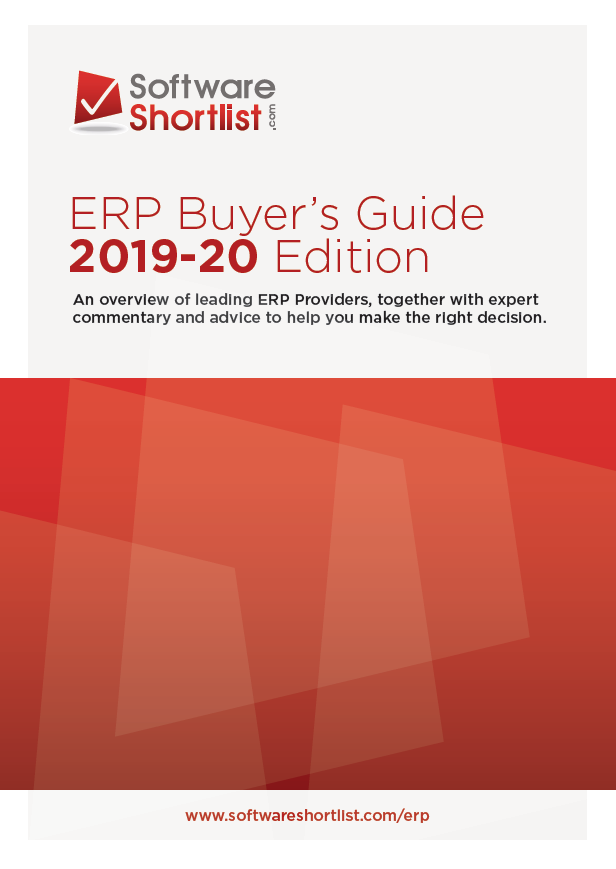 In 2018 it’s cloud or nothing for ERP vendors in the A/NZ region, but in a hybrid world is purer better?…
In 2018 it’s cloud or nothing for ERP vendors in the A/NZ region, but in a hybrid world is purer better?…
It’s been some time coming and it should be no surprise: interest in enterprise resource planning (ERP) solutions is strongly oriented to the cloud.
The question these days for buyers of ERP is less about on-premise versus cloud and more about cloud-native versus cloud-enabled. The right answer will always depend on your specific circumstances as complex environments can and do muddy the waters.
The accompanying 2018-19 edition of Software Shortlist’s ERP Buyer’s Guide comes with tools and information that will help you start down a winding pathway in a journey of discovery. The way will be rocky, the path not always clear and the cloud occasionally ominous, but the benefits can be significant.
With iStart providing guidance on the state of the ERP market since 2001, the shift to cloud has appeared inexorable, yet paradoxically it has taken longer than expected. It’s the nature of the beast, where barriers such as outsourcing your core security or worrying about internet accessibility were enough to see conservative decision-makers keep the knitting close to home.
“Clunky old enterprise software just doesn’t cut it for supporting new digital-first business models.”
It’s always safer to let others blaze the trail when it comes to these new fandangled technologies.
But now, it appears critical mass is reached, particularly in New Zealand where fibre connectivity is practically ubiquitous, fast and reliable; and if not quite yet so for Australians, the ‘cloud’ is now located, if only in theory, just up the road. Arguments against have been weakened in favour of the democratised, consumerised, easy-to-use and always-on software promises of the cloud.
And urgency is only growing. Those trailblazers, unhindered by legacy constraints, have disrupted markets leaving slower moving incumbents playing catch up. Clunky old enterprise software just doesn’t cut it for supporting new digital-first business models with intelligence-based customer-centricity. Nor for keeping an increasingly savvy staff happily using it.
It is unsurprising then that Gartner Group, the researcher responsible for creating the term ‘ERP’ in the first place (back in the 1990s), in its Magic Quadrant for Cloud Core Financial Management Suites for Midsize, Large and Global Enterprises, notes that it has seen a major increase in the number of end-user inquiries about cloud solutions, mainly of the public cloud variety, at the expense of activity for on-premises or hosted solutions. The researcher has even appended the arty term ‘postmodern’ to the emerging ERP solutions. A term that, in our view, is simply a fancy way of saying ‘cloud’.
It isn’t difficult to imagine why interest is strong in favour of cloud solutions, but we’ll skim over the reasons that this is the case (which apply to just about any cloud service versus an on-premise equivalent):
Cloud solutions:
- Make it easier to stay current with incremental updates
- Offer a better interface which approaches the usability of consumer services
- Provide advanced features including analytics
- Offer improved agility and the rapid introduction of new functionality
- Reduce reliance on IT staff for managing applications
Note that ‘cost’ doesn’t come into the equation and for good reason. While cloud vendors like to lead with ‘lower up-front costs’, the recurring subscriptions and incremental pricing for seemingly low dollar per user extra features, means costs can accumulate into substantial and ongoing sums. Make no mistake, cloud or not, ERP software is still expensive, and it can be just as complex as ever.
But, given the fluidity of business practices today, modern software has also arguably never been more accessible, nor more necessary to survive.
Defining cloud
The features and benefits of cloud solutions define cloud applications, and these are further enhanced by wider ecosystems that have evolved to address most business problems with plug and play solutions. But there’s more to it than that. The rub of the green is now steering interest toward ‘cloud native’ versus on-premise solutions dressed up and made browser-ready.
‘Proper’ cloud solutions are delivered exclusively via browser on a software as a service (SaaS) basis, and, usually, were built that way. The hallmarks are:
Applications are delivered and managed remotely using a common codebase that uses the same database architecture.
- Applications are consumed in a one-to-many fashion by all customers in a shared tenancy environment.
- Applications are billed on a pay-for-use basis or a subscription based on usage metrics.
- The applications are built on shared resources to provide elasticity.
- Applications are screen-agnostic and will present user-friendly screens on any device.
If these conditions aren’t met, you’re probably dealing with a hosted solution, and not true cloud-based SaaS. Put another way, cloud native solutions were designed and built in the cloud.
They are distinct from desktop applications which have been re-architected to run in a browser, and which are typically capable of being deployed in multiple architectures (cloud, private cloud or on-premises); or client-server solutions which are delivered hosted in a public cloud. For the latter, the underlying architecture is the same, but an infrastructure-provisioning layer is introduced on virtual servers, so that SaaS can be offered.
“Given the fluidity of business practices today, modern software has also arguably never been more accessible, nor more necessary to survive.”
While you, the buyer, should rightly be focused on the features and functions needed to support your specific requirements, you really do need to exercise due diligence on what you are buying. Assumptions and misunderstandings will have long term and far-reaching consequences.
While it’s not possible to be definitive about which choice is best, if you are in the process of selecting an ERP, the sensible option is to look for a modern solution which isn’t weighed down by technical debt from decisions past.
Vendors more accustomed to doing business the on-premise way will be able to promise you more customisation, but it will come not only with business and technical consulting fees, it may also compromise future access to new releases. If resources are tied up delivering customer solutions, they are not working on innovations for the next release.
The problem of introducing ongoing innovation and automation doesn’t go away, it simply moves delivery risk on to the vendor, and they have more at stake.
Long live on-premise
While tempting to imagine cloud as a fait accompli, there is little uniformity in the market, both in terms of maturity and in terms of adoption. Smaller applications that lay claim to being ‘mini ERPs’ have little in common with ‘true’ enterprise deployments; while the former can be subscribed to and implemented in anything from an afternoon to a week, the latter, even in the cloud, are still going to take weeks, months or years.
For many vendors targeting customers at the smaller end of the scale, maturity has come quickly. This is for at least four obvious reasons: relative simplicity, a far greater addressable market (in terms of absolute numbers of prospects), a different risk profile and less cash sloshing around; vendors interested in this market have had to price for it. As a result, while they may be able to say they have inventory, e-commerce or manufacturing modules (say), the depth of functionality may not support the needs of complex multi-tier businesses.
Not so at enterprise scale. Aversion to risk, deeply embedded industry solutions and conservative cultures have conspired to build an inertia to changing systems at all, let alone from on-premise to cloud. There are many companies in which a move to cloud might never happen. The death of on-premise ERP will not be a prediction we’d make in any hurry.
But for anything other than our largest conglomerates, coming from the A/NZ region translates to being in the midmarket in global terms. And the good news is that we’re seeing a gallop to maturity as solutions gain sophistication. The vendor landscape continues to evolve and the quality of systems and services available continues to improve, with an increasing number of vertical solutions available to meet the needs of specific industry types.
On that note, it is always advisable to seek out a vendor which has the chops in your industry vertical. ERP is like marriage; difficult, lengthy, risky, sometimes frustrating, but done right it is hugely rewarding. Done wrong… well, you might have heard. Even Gartner makes the point that in this still-evolving landscape caveat emptor is common sense. In its words: “not all [vendors] can sell effectively to all the sectors they target”. Check, with a microscope, that track record.
Hybridise
We’ve mentioned how complex enterprises are the slowest to make the move to cloud. But as you’ll instinctively recognise, very large companies are also major users of all manner of cloud services. This has given rise to the hybrid approach to enterprise applications, and it is an approach which can have applicability for the midmarket. Can, because we’re strongly of the view that the fewer vendors you need deal with, and the fewer customisations on or integrations with your ERP system, the better you’ll be for it.
Nevertheless, it’s not uncommon at the top of town to see strategies whereby on-prem ERP is being augmented with best-in-class cloud solutions. Take this as a further endorsement of the validity of the cloud for business-critical applications: things like travel expenses or marketing campaign management are so much better in the cloud that they are irresistible. Even to those committed to, or stuck with, on-premise systems.
The basics still apply
‘Cloud’ as it applies to ERP is often dismissed as being nothing more than your applications on someone else’s computer and to a large extent, that’s true. As mentioned, don’t imagine that because it’s cloud, the project will be easier or even faster. It is still a major software project and even a smooth-running one will deliver up headaches aplenty.
And that means making the transition to cloud should be approached with precisely the same vigour and rigour as any other major project.
We’ll save ERP project scoping and implementation methodologies for another day, but make no mistake, they will define success or failure regardless of the product chosen.
If you are at the selection and evaluation stage, then now is the time to address project governance. Start with clear definitions of problems and goals, identify and quantify what success will look like (and how it will be measured), seek quantitative measures where possible and bring everyone along for the journey, from executive management down to those who will work with the system and its outputs. ERP is so fundamental to the running of your company that the project’s business case must indelibly link to your business strategy.
And if you are moving to the cloud, bear in mind you should build in room for innovation. Things will move faster than in the on-premise world, and you will need to constantly adapt to take advantage (because you can). You will also need to engage in the community around your chosen path to ensure user feedback drives innovation in the directions that you want.
But, perhaps best of all, with the incredible range of technology available today, that most important metric of all – time to value – should be around sooner rather than later.



